EAYC Poland Trip 2010
About the Trip
For many years Rabbi Lieberman had wanted to lead members of his community on a visit to Poland. In June 2010 this dream became a reality and it was arranged for a group of 31 people to go on a 2 day intensive trip to the Krakow area. The group was a mix of old and young, married couples, fathers and sons all wanting to gain a deeper understanding of the Churban.
A few days before we left, and in order to prepare us for the trip, we were privileged to listen to one of the leading authorities on the Shoah, Gena Turgel, who in her special way gave us an account of her time in the camps. There could have been no better way of putting into perspective what we were about to encounter and hopefully help us understand on a humanistic level what we were about to see.
At 3:15am on a cold Sunday morning in June, our group of 31, people mostly from the Edgware Adath Community met up to begin our journey together.
After an impromptu Shacharis at an empty sea food bar in the middle of Stansted departure lounge, we boarded our Ryanair flight and landed in a grey Krakow at 9.30am - it was raining heavily and we quickly made our way to the coach with our guide Sara Pelach.
A few days before we left, and in order to prepare us for the trip, we were privileged to listen to one of the leading authorities on the Shoah, Gena Turgel, who in her special way gave us an account of her time in the camps. There could have been no better way of putting into perspective what we were about to encounter and hopefully help us understand on a humanistic level what we were about to see.
At 3:15am on a cold Sunday morning in June, our group of 31, people mostly from the Edgware Adath Community met up to begin our journey together.
After an impromptu Shacharis at an empty sea food bar in the middle of Stansted departure lounge, we boarded our Ryanair flight and landed in a grey Krakow at 9.30am - it was raining heavily and we quickly made our way to the coach with our guide Sara Pelach.
Kazimierez District
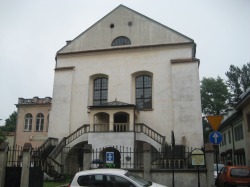
We initially set off for the Kazimierz District area of Krakow - what was once the heart of Jewish Life in the city, where all the Jewish people lived and worked (not to be confused with the Ghetto which only came into effect with the Nazi regime.)
Crossing the Vistula river and arriving at Kazimierez, we immediately saw the grand Alte Shul, one of the oldest remaining shul’s in Europe – which like many, now functions as a museum. Walking through the streets you could still see the carved gaps where the mezuzos once were which was a further stark reminder of how this city used to be, just 70 years ago.
The rain poured as we wandered through the streets, through a market, where we visited an old yeshiva from 1810, the Issac Shul which like many shul’s was used as a stable by the Nazis, and then on to the small personal Shul of the Remo. At the back of this shul was the cemetery where the Remo and many gedolim were buried. The only reason the cemetery wasn’t destroyed by the Nazis was that most of the gravestones were buried, hidden from human eye, which is the case for much of the cemetery. Like many memorials in Poland and Krakow, restoration is being carried out by various groups marking them as important sites accessible to the world.
Crossing the Vistula river and arriving at Kazimierez, we immediately saw the grand Alte Shul, one of the oldest remaining shul’s in Europe – which like many, now functions as a museum. Walking through the streets you could still see the carved gaps where the mezuzos once were which was a further stark reminder of how this city used to be, just 70 years ago.
The rain poured as we wandered through the streets, through a market, where we visited an old yeshiva from 1810, the Issac Shul which like many shul’s was used as a stable by the Nazis, and then on to the small personal Shul of the Remo. At the back of this shul was the cemetery where the Remo and many gedolim were buried. The only reason the cemetery wasn’t destroyed by the Nazis was that most of the gravestones were buried, hidden from human eye, which is the case for much of the cemetery. Like many memorials in Poland and Krakow, restoration is being carried out by various groups marking them as important sites accessible to the world.
Auschwitz 1 - 'The Museum'
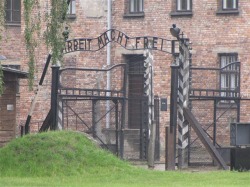
Most of us had only seen Auschwitz and Birkenau in films or read about them in books, and as such there was a real feeling of anxiety on route to the death camps. With many coaches and tourists at the entrance of Auschwitz 1, it was difficult to imagine the atrocities that occurred there. This quickly changed when we walked under the infamous sign “Arbeit macht frei”, “Work makes free”. Auschwitz 1, an old Polish army camp had been changed to a work camp by the Nazis and today into a comprehensive museum. Where once inmates had slept, barracks have been changed into exhibit rooms housing inmates’ belongings. It remains difficult to understand the scale, but after seeing thousands of shoes, glasses, cases and prosthetic limbs, the enormity of what happened became clearer.
Suitcases of arrives with their names on in bold print made everything far more real and focused the mind that these were ordinary people sent to this place for no other reason but their religion.
Maybe one of the hardest exhibits to view was the model of the gas chambers accompanied by a step-by-step account of how this death machine operated.
We gazed at pictures of the confused people arriving at the camps and could not help but imagine our own family members replacing these poor souls -another stark reminder of how much we need to be grateful for what we have.
Standing outside Mengele’s house of torture listening to our guide recounting stories of poor souls who came under his watch, it was difficult to believe the world allowed this to happen. After lighting memorial lights in a dark room listening to the Rabbi and Sara telling us stories of those who had been at Auschwitz, we knew it was time to confront the part of the trip most feared.
Suitcases of arrives with their names on in bold print made everything far more real and focused the mind that these were ordinary people sent to this place for no other reason but their religion.
Maybe one of the hardest exhibits to view was the model of the gas chambers accompanied by a step-by-step account of how this death machine operated.
We gazed at pictures of the confused people arriving at the camps and could not help but imagine our own family members replacing these poor souls -another stark reminder of how much we need to be grateful for what we have.
Standing outside Mengele’s house of torture listening to our guide recounting stories of poor souls who came under his watch, it was difficult to believe the world allowed this to happen. After lighting memorial lights in a dark room listening to the Rabbi and Sara telling us stories of those who had been at Auschwitz, we knew it was time to confront the part of the trip most feared.
Auschwitz - Birkenau - The Factory of Death
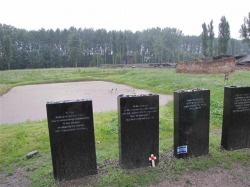
Five minutes away was the death camp Birkenau. What struck us immediately was the vast enormity of this eight square kilometer death factory.
We were taken around the remaining barracks, seeing the 3-tiered bunks on which 7 or more adults would have slept and the meagre heating system where the prisoners would have tried to keep warm. We saw the toilet block where hundreds would have been on the toilet together with no form of privacy, and heard the stories of people who felt 'lucky' to be given the job of cleaning the toilet blocks - why? because the job was indoors and in the warm, and becuase they sometimes found pieces of jewellery in the 'muck' that they could barter for a bit of bread.
One of the most poignant stories told by our guide was that on a previous trip someone had asked an accompanying survivor whether the lush grass they were now standing on was there whilst she was an inmate. The powerful and telling response she gave was: “If there was grass on the ground, we would have eaten it”.
After walking up the rail tracks where inmates arrived to be confronted with the Nazis determining whether they lived or died, we became more and more startled by the enormity of the site and were not able to comprehend how people managed to survive in the cold, harsh winter there with no warm clothes and little to eat. We saw the famous gas chambers, now fallen to ruin, and we had the opportunity to visit a pit filled to the top with ashes of those who perished in the gas chambers. Rabbi Lieberman read a letter he wrote to the grandmother he had never met who perished at Birkenau and we sang 'Ani Ma'amin', recited Yizkor lit a yarzheit candle, bringing many to tears.
With the light fading we walked silently back to the coach, mentally and physically drained.
We were taken around the remaining barracks, seeing the 3-tiered bunks on which 7 or more adults would have slept and the meagre heating system where the prisoners would have tried to keep warm. We saw the toilet block where hundreds would have been on the toilet together with no form of privacy, and heard the stories of people who felt 'lucky' to be given the job of cleaning the toilet blocks - why? because the job was indoors and in the warm, and becuase they sometimes found pieces of jewellery in the 'muck' that they could barter for a bit of bread.
One of the most poignant stories told by our guide was that on a previous trip someone had asked an accompanying survivor whether the lush grass they were now standing on was there whilst she was an inmate. The powerful and telling response she gave was: “If there was grass on the ground, we would have eaten it”.
After walking up the rail tracks where inmates arrived to be confronted with the Nazis determining whether they lived or died, we became more and more startled by the enormity of the site and were not able to comprehend how people managed to survive in the cold, harsh winter there with no warm clothes and little to eat. We saw the famous gas chambers, now fallen to ruin, and we had the opportunity to visit a pit filled to the top with ashes of those who perished in the gas chambers. Rabbi Lieberman read a letter he wrote to the grandmother he had never met who perished at Birkenau and we sang 'Ani Ma'amin', recited Yizkor lit a yarzheit candle, bringing many to tears.
With the light fading we walked silently back to the coach, mentally and physically drained.
Plaszow Concentration Camp
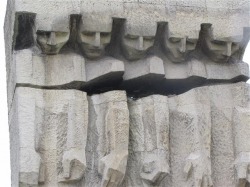
On the second day, after another early start we went back to the Issac Shul for Monday morning Leining, led by Jonny Dickson. After a quick but as always fascinating Polish history lesson by the Rabbi, we boarded our coach and headed for Plaszow, made more famous by being the focus of the film Schindler’s List. Where once stood Amon Goeth’s living quarters now stands a powerful monument depicting five survivors’ clenched fists looking down trodden the only reminder of this once truly horrible place. As promised to Gena Turgel, we lit candles on her behalf in memory of her lost family members.
Zbilitowska Gora

Our next stop was Tarnow/Zbilitowska Gora, one of many mass graves. It is estimated that a further 1.5 million, over and above the commonly referred to 6 million Jews lost their lives in such places. It is also worth pointing out that there are around 3,000,000 searches on Google for Auschwitz and only 100 for Zbilitowska Gora.
At Zbilitowska Gora we were guided down into the thick, dark forest and came to a clearing, where only a few decades previously 10,000 Jews were murdered in the cold light of day and buried in mass graves. They were separated and the parents were forced to watch as their children were slaughtered before they also befell the same fate. At the designated children’s grave site, outlined by a blue fence and banners, flags and toys from visitors from all over the world had been left as symbols of hope and we sang Hamalach hagoel…. bringing many to tears. To put this into perspective that is almost twice the number of Jews in Edgware in one mass gravesite and this scene was repeated throughout Europe.
Rabbi Lieberman explained that an Italian Roman Catholic has dedicated his life to uncovering these hidden mass graves, where so many Jews met an undignified death.
At Zbilitowska Gora we were guided down into the thick, dark forest and came to a clearing, where only a few decades previously 10,000 Jews were murdered in the cold light of day and buried in mass graves. They were separated and the parents were forced to watch as their children were slaughtered before they also befell the same fate. At the designated children’s grave site, outlined by a blue fence and banners, flags and toys from visitors from all over the world had been left as symbols of hope and we sang Hamalach hagoel…. bringing many to tears. To put this into perspective that is almost twice the number of Jews in Edgware in one mass gravesite and this scene was repeated throughout Europe.
Rabbi Lieberman explained that an Italian Roman Catholic has dedicated his life to uncovering these hidden mass graves, where so many Jews met an undignified death.
Bobova Shul
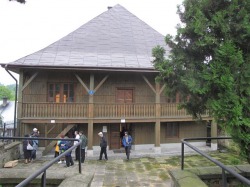
We then made the journey further into Galicia to Bobov, a once densely-populated Jewish community, many of whom were sent to their deaths at Auschwitz and Plaszow. We visited the original Bobov shul, which once housed a thriving community, the legacy of which now continues around the globe.
Warsaw Ghetto Area and Schindler's Factory
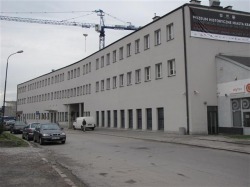
We continued our visit taking in Schindler’s factory, the Jewish Museum and the Kazimierez ghetto area with its emotive walls looking like tombstones.
And finally, tired and drained we returned to London, somehow changed but definitely uplifted, late on Monday evening.
At a follow-up session, sitting around the Rabbi’s table we listened to Lily Ebert, a Hungarian survivor of Auschwitz, re-telling her fascinating story, and exchanged views on how the trip had affected us as individuals. Questions were asked how people like Lily could keep their faith and whether an atrocity like this could ever happen again. The clear response from Lily was that it was indeed faith that kept her, like many others, alive. To view video's of this session, please go to the 'Survivor Testimony page'.
The trip was a true success, leaving those who joined us feeling privileged to live today in a society that allows freedom of religion and more specifically the right to be Jewish and be proud of it.
Where those people who 70 years ago were denied such rights, we now have the opportunity to live a full Jewish life with our families and within our very special community.
We hope that this will be the first of many further trips to the Poland and that by doing so people will continue educating themselves on what happened in one of the darkest periods of our history
At a follow-up session, sitting around the Rabbi’s table we listened to Lily Ebert, a Hungarian survivor of Auschwitz, re-telling her fascinating story, and exchanged views on how the trip had affected us as individuals. Questions were asked how people like Lily could keep their faith and whether an atrocity like this could ever happen again. The clear response from Lily was that it was indeed faith that kept her, like many others, alive. To view video's of this session, please go to the 'Survivor Testimony page'.
The trip was a true success, leaving those who joined us feeling privileged to live today in a society that allows freedom of religion and more specifically the right to be Jewish and be proud of it.
Where those people who 70 years ago were denied such rights, we now have the opportunity to live a full Jewish life with our families and within our very special community.
We hope that this will be the first of many further trips to the Poland and that by doing so people will continue educating themselves on what happened in one of the darkest periods of our history
